
Investing
in research, making a difference.
Reopening, Reengaging, Reinventing
Following two years of our world in a pandemic, our university and broader community have begun the process of reconnecting with each other. The constant concern for safe interactions has given way to an intense need to see one another, to speak in person and to chart the future together.
Our work at WARF in supporting scientific innovation remains a steady partnership with our university community. We found new opportunities to engage and bring the potential our technologies hold to new friends within the state, around the country, and in industry. As WARF draws closer to its centennial year of service in 2025, I am proud of how our optimism and tenacity bypasses the hurdles that even a global pandemic present.
This season, let us share with you some of our favorite moments from this year. In these pages you will find many stories of reopening, reengaging and reinventing:
• Hear how a medical technology recently licensed to Hexokine Therapeutics is destined to improve the lives of those impacted by epilepsy.
• Discover how UW-Madison innovators rose to our Electrification Challenge.
• Celebrate our 2022 WARF Innovation Award nominees, representing some of the most innovative disclosures presented to our staff this year.
• Hear about UW entrepreneurs working with WARF Accelerator to share their technologies and startups at the regional investor forum, Summerfest Tech.
• Explore our robust WARF Therapeutics pipeline.
• Learn the promise of a WARF Ventures portfolio company –Stuart Therapeutics – which is advancing a unique reparative tissue platform providing much-needed relief for dry eye disease patients.

I hope you enjoy the latest updates from our intellectual property & licensing team and so much more. I am proud of our accomplishments and most of all, our staff, Trustees and partnerships, this year.
I wish you and your family a joyous season, and a healthy and peaceful New Year.
All the best –
Chief Executive Officer Wisconsin
Alumni Research Foundation (WARF)


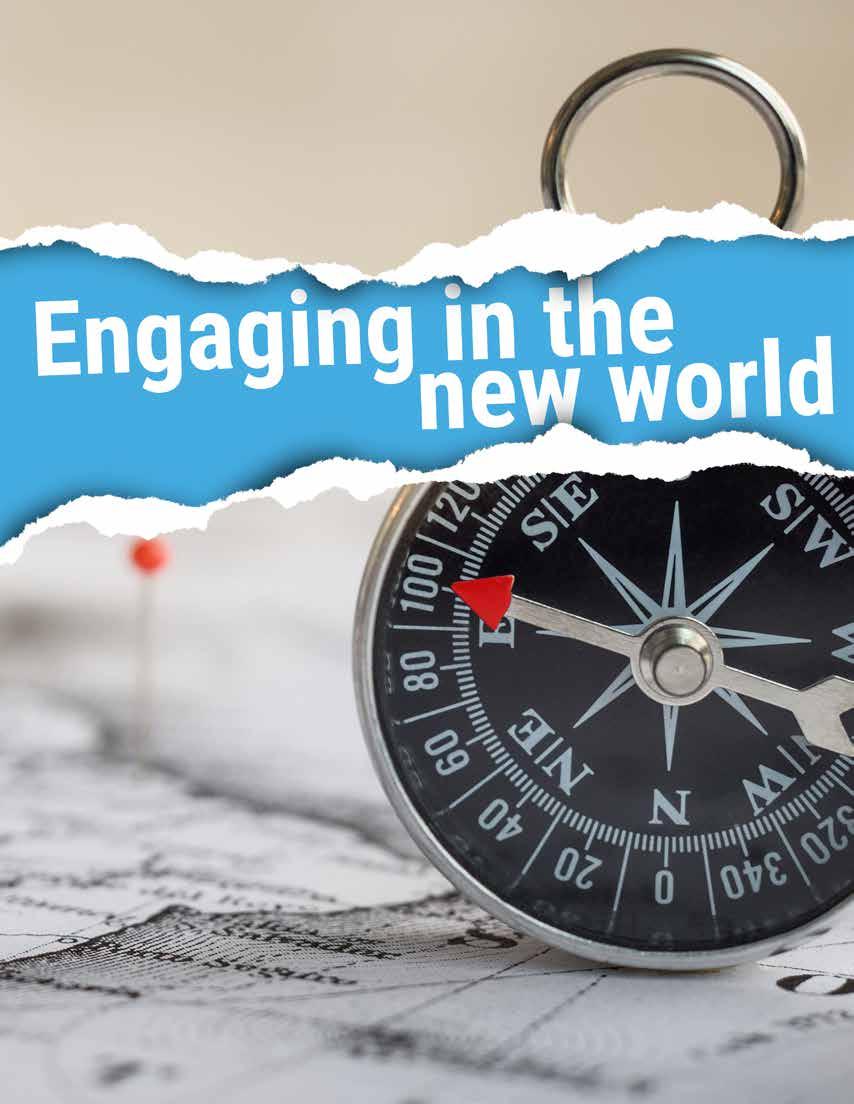
WARF’s Support to the University of Wisconsin-Madison and Morgridge Institute for Research
Annual grant
Nothing better accomplishes the purpose of WARF’s mission than the direct grants and in-kind support that we provide to the UW-Madison research community. In the words of CEO Erik Iverson, “announcing our annual grant is the highlight of our year.”

WARF total support to UW-Madison each year can be broken down into three components: the time-honored base grant, targeted and timely supplemental grants, and operational and functional support for innovative research. Added together, and including support to the Morgridge Institute for Research, WARF provided $130.0 million across fiscal year 2023.
Base grant

Continuing a tradition dating back to the 1930s, the WARF Board of Trustees approved the 2023 base grant in response to a formal request from UW-Madison’s Office of the Vice Chancellor for Research and Graduate Education (OVCRGE). At $66.1 million, this year’s base grant saw a 4% increase over the same amount last year. Those funds will cover faculty fellowships, graduate student support and the fall research competition, among other research initiatives.
Supplemental Grants
This year, WARF announced supplemental grants to UW-Madison valued at $21.7 million. Also determined in close collaboration with the OVCRGE, these grants include special STEM initiatives, funds for the WARF Accelerator and WARF Therapeutics programs, and the anticipated distributions of royalty funds to campus departments. WARF also provided $6.0 million to the Morgridge Institute for Research in recognition of the private, nonprofit institute’s ongoing mission to improve human health through interdisciplinary biomedical research.
Operational and Functional Support
While most universities bear the cost of technology commercialization and asset management through their own budget, WARF’s mission-driven operational and functional support has provided those services to UW-Madison since 1925. This unique model stands alone in American higher education. These services were valued at $36.2 million for fiscal year 2023.
WARF’s first financial support for UW-Madison came in 1928 with a grant for $1,200. The amounts have dramatically increased, and so has the volume of science conducted on campus. But our annual support continues a long and proud tradition nearly a century old.

6
WARF’S STRATEGIC PLAN
2023-2027

The WARF Board of Trustees endorsed WARF’s five-year strategic plan in October, and staff have mobilized to meet the refreshed direction for how WARF will meet our mission to support the University of Wisconsin-Madison and the Morgridge Institute for Research.
The plan has an important Foundational Principle: Communications
This principle is intended to ensure open, urgent and effective communications and ongoing feedback within WARF and with external stakeholders.
Each pillar is further defined as follows:
Financial Strength – Create opportunities for financial strength through well-executed efforts in traditional and innovative programs that take advantage of WARF’s technology transfer and asset management expertise.
• Revenue. Increase annual revenues from licensing and ventures to exceed operating expenses.
• Operating Efficiency. Ensure WARF’s limited resources are utilized efficiently with attention on strengthening core competencies.
• Asset Management. Strategically manage WARF’s balance sheet - patent portfolio, investments and real estate.

Supported Organizations – Support the UW-Madison community in dynamic and thoughtful ways, including dynamic support to help identify and receive additional research funding from a variety of sources.
• Annual Grant. Ensure strategic growth and use of WARF’s annual research grants.
• Strategic Financial Support. Support the University and the Morgridge Institute for Research with targeted grants to support periodic special projects and infrastructure.
• Collaborative Support. Provide support to assist the UW-Madison community in its research efforts, including capturing government and industry grants.
People – Build and foster an environment for success that translates our values into productive and rewarding actions and energizes individuals to carry out WARF’s mission and vision.
• Culture. Live a values-driven culture.
• Relationships. Engage with a wide range of stakeholders to carry out WARF’s mission and vision.

• Diversity, Equity and Inclusion. Ensure WARF’s hiring and operating policies promote diversity, equity & inclusion.
Through staff retreats and department planning, the plan will become fully operational in 2023.
7
Progress on the new CDIS building
UW School of Computer, Data & Information Sciences

The new CDIS building – expected to open in early 2025 – is under development and immediately across Orchard Street from the Discovery Building. Designed to be the most sustainable facility on campus, the building will complete UW-Madison’s tech corridor and be a hub for Wisconsin and the world to advance research at the intersection of technology and humanity.

Funded entirely through private resources, the more than $225 million facility is supported by $50 million from WARF as well as a $125 million commitment from former WARF Trustee and UW alum John Morgridge and his wife Tashia.
CDIS brings together the departments of Computer Sciences, Statistics and the Information School to serve the computing, data and information needs of our ever-changing world. By bringing these programs together under one roof, CDIS will magnify the power of discoveries across the university in medicine, engineering, agriculture, business and more.
In 2022, two buildings were torn down to clear room for the 328,000 square foot development.
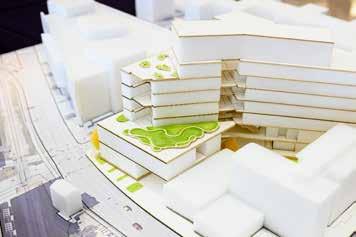
“Computing is changing the world and there is no place on campus, or in modern society, where that isn’t true,” says Tom Erickson, Founding Director of CDIS. “It’s why we brought together these disciplines and are investing in a space dedicated to fostering collaboration, which in turn, will drive innovation and economic development in the state, region and beyond.”
“We’re thrilled to help in launching a new era for the UW School of Computer, Data & Information Sciences,” says Erik Iverson, CEO of WARF. “We share the vision of this campus catalyzing technologies with the power to shape societies. The mixing of disciplines in the school and its innovative new facility will enable intellectual collisions that will further drive innovation.”
8
The UW School of Veterinary Medicine EXPANDS


EXPANDS

This year we have observed the progress on the expansion of the UW School of Veterinary Medicine (SVM). On June 18, 2021, construction began as the growing school needed more space. The addition and renovations will double the school’s small animal hospital, expand the large animal hospital, improve instruction space for students, and increase and modernize research spaces. The addition is expected to be completed by fall 2023 and renovations of the existing building in late 2024.
A $15 million gift from WARF will support the expansion. “We are grateful for WARF’s generous gift and continued partnership with the school and university to fuel innovation,” says School of Veterinary Medicine Dean Mark D. Markel.
“We are pleased to support this addition and renovation to allow the SVM to continue its trajectory of excellence,” says Erik Iverson, WARF’s CEO. “The school performs globally vital research that generates important breakthroughs for not only animal but also human health.”
9
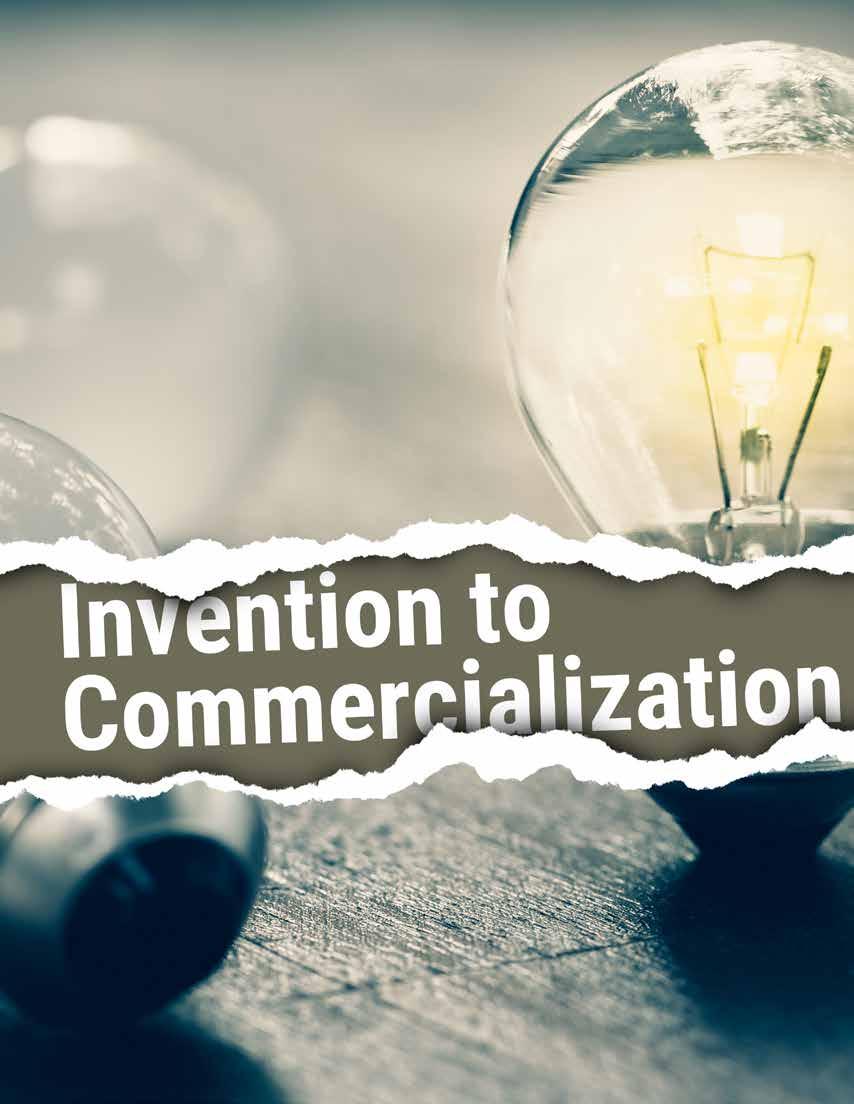
Innovative research and discovery across disciplines

Disclosing an invention can be the first step in a lifechanging journey. Iconic technologies, from stem cells to microprocessors, come through WARF’s doors as disclosures. And great ideas across all disciplines feed this steady disclosure pipeline.
Of the 400+ disclosures submitted to WARF in fiscal year 2022, the College of Engineering and the School of Medicine and Public Health were the biggest contributors. But they were not alone. From Letters and Science to Veterinary Medicine, Pharmacy to Agricultural and Life Sciences – innovation is alive across campus.
“To receive an average of more than one disclosure every day for a year shows the great research and inventive thinking taking place at UW-Madison,” says Michael Falk, WARF’s Chief Intellectual Property and Licensing Officer. “These are technologies to treat disease, revolutionize agriculture, improve safety and make our world greener.“
Disclosures
School of Human Ecology
School of Business
School of Nursing
School of Education
School of Pharmacy
School of Veterinary Medicine
OVCRGE

College of Letters and Science
College of Agricultural & Life Sciences
School of Medicine and Public Health
DISCLOSURES
0 20 40 60 80 100 120 140
College of Engineering

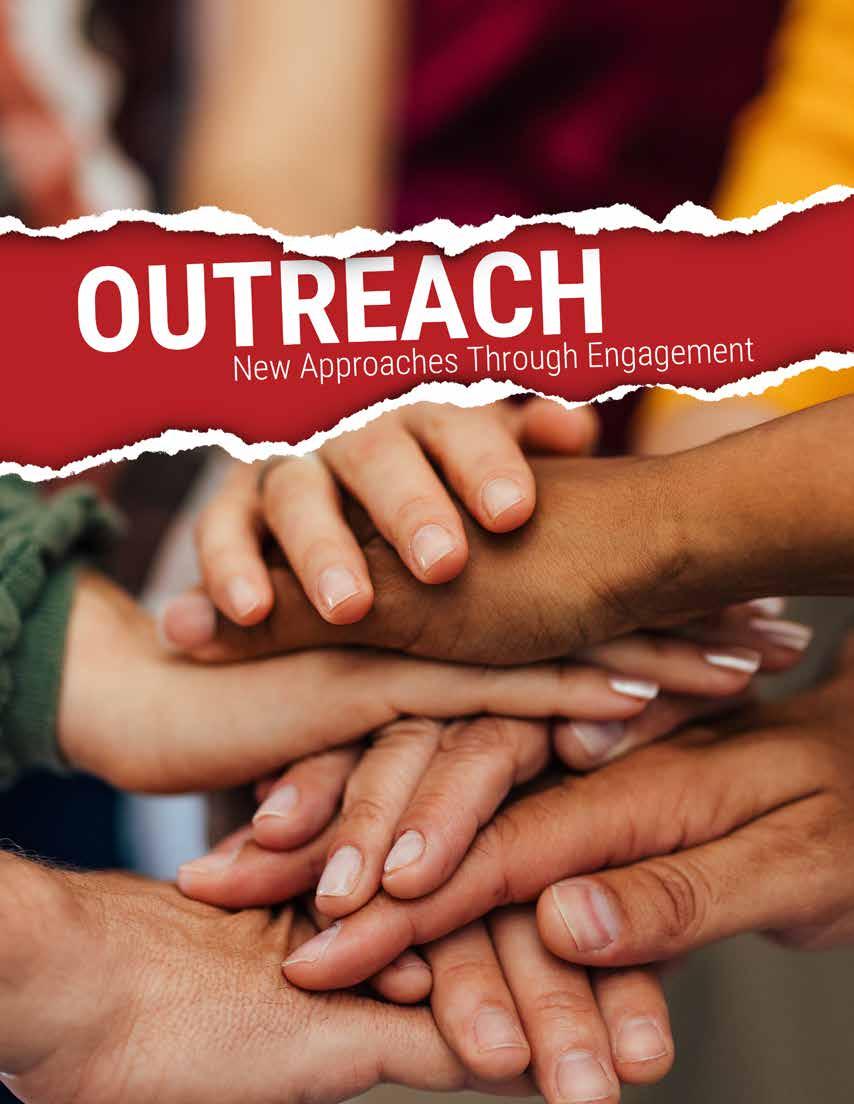
UW/ WARF ELECTRIFICATION CHALLENGE









During fiscal year 2022, WARF Accelerator issued a campus-wide Challenge Grant focused on electrification –the use of new technologies for leveraging electricity from non-fossil fuel sources to power our buildings, vehicles and world.



WARF launched the concept of its Challenge Grants one year prior, at the height of the COVID pandemic, to inspire and advance innovations in sectors of strategic commercial potential, from the tiny but dynamic microbiome to next-generation manufacturing. The targeted funding has helped innovators across campus pursue proof-of-concept work critical for building momentum behind emerging technologies. The fourth grant invited submissions focused on a theme – electrification – essential to meeting future global energy needs. The selected projects hold promise for reducing carbon dioxide emissions and lowering energy costs. The selected projects:
Lead PI: Song Jin (Chemistry) with Dawei Feng and Ethan Auleciems for high performance and commercially practical solar flow batteries – a potentially game-changing energy technology that combines the functions of solar cells and rechargeable batteries in a single system by converting solar energy into chemical energy. This project looks to achieve higher efficiency with lower costs.

Lead PI: Chirag Gupta (Electrical & Computer Engineering) with Daniel Ludois and Shubhra Pasayat for a streamlined transistor design that could improve the energy efficiency of power electronics. This technology could one day help the grid deliver stable and reliable electric power derived from renewable energy.
Lead PI: Matthew Gebbie (Chemical Engineering) with Bingchen Wang, John McAlpine and Ryan Cashen for a new class of electrolytes to support next-generation batteries. A multibillion-dollar market, batteries are essential for the decarbonization of transportation and energy grids. But mounting environmental and human costs are driving interest in developing new “beyond lithium” batteries. This project draws on recent advances in the field to envision emerging battery chemistries.
Lead PI: Eric Severson (Electrical & Computer Engineering) and Nathan Petersen for a cost- and weight-saving design to sense rotor displacement in electric machines. The need for this kind of ‘condition monitoring’ is rapidly growing in critical electrification spaces including electrified cars, aircraft, construction/agriculture vehicles and wind turbines in remote locations. With space and weight at a premium in these motor designs, a highly integrated sensing solution is needed.
“UW-Madison continues to lead the way in pioneering, cutting-edge research,” says Leah Haman, WARF Intellectual Property Manager. “We are thrilled to see the breadth of technologies submitted as proposals, and the quality of proposals made it hard to select which to fund. We are proud to support these technologies, including fundamental innovations in battery chemistry and electric machines, that can help us achieve our future goals around electrification.”
13
Song Jin
Matthew Gebbie Ryan Cashen
Dawei Feng Ethan Auleciems
Eric Severson Nathan Petersen John McAlpine
Shubhra Pasayat
Daniel Ludois Chirag Gupta
Getting the
WORD OUT
As one of the world’s oldest tech transfer organizations, WARF’s marketing vehicles have evolved with the times. Depression-era vitamin promotions were supplanted by print mailings, which in turn transformed into emails, social media posts and digital campaigns.
The eternal challenge: keep Badger discoveries top of mind in increasingly competitive global industries.
This year witnessed the implementation of best-in-class software platforms, novel campaigns directed to campus researchers and potential licensees, and the launch of four new industry-specific newsletters.
A working group drawn from WARF’s IP & Licensing, Communications and Ventures teams developed and deployed the new offerings in collaboration with a Madison-based firm, Market Crafters LLC.
“This was the beginning of a great collaboration between our Strategic Communications team and our IP and Licensing colleagues,” says Jeanine Burmania, Senior Director, IP and Licensing. “We are enhancing awareness of WARF on campus, showing faculty and researchers that we are here to support their innovations, and increasing exposure of our technologies with industry. We are thrilled with the response we are receiving from campus from these efforts and are optimistic that they will enhance our business development efforts and industry network.”
GROWING DISCLOSURES

Game-changing technologies, whether stem cells or parallel computer processing, come through WARF’s doors as innovation disclosures. And many campus researchers know that disclosing is the essential first step on their path to market. Others may not. Or they may underestimate the commercial potential of their discoveries.

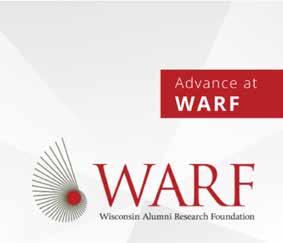
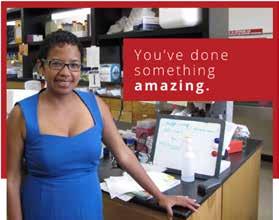
To maximize outreach, the working group built out a new Salesforce platform – called Pardot – to customize messaging to campus on a steady but unintrusive schedule. Specifically, the campaign seeks to re-engage researchers who have not disclosed to WARF over the prior two years.
The results: 10 new disclosures within the month of launch and renewed communication between campus researchers and WARF intellectual property managers. Additional campaigns are planned for the fall and spring semesters.
Cross-departmental team pilots new marketing tools and tactics to keep UW tech at the fore
REACHING INDUSTRY
Digital ads may seem ubiquitous, but WARF just might be the first tech transfer office using them to target prospective licensees. The working group designed a series of ads aimed at building awareness of WARF and our high potential technologies, and nurturing leads to opt-in to our communication channels.
The results: ads targeting clean tech, power electronics and immunotherapy companies each drew more than 1,000 visitors to the WARF website to learn more.
WARF ADVANCES
WARF ADVANCES
Summer saw the launch of not one but four industry-facing newsletters. Under the banner WARF Advances, these quarterly updates highlight our highest potential technologies in the following verticals: Engineering & Computer Science, Food & Agriculture, Clean Tech and Health Care.

With nearly two thousand subscribers, the number of readers continues to grow. Want to learn about new dimensions in virtual reality? Or atomically thin semiconductors that could drive the next revolution in electronics? Or drug development models of the brain and spinal cord? Sign up at warf.org/WARFAdvances.
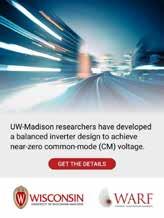
Facts, Factoids & Figures
11,359 users visited warf.org in June 2022, up 92% from June 2021.
216 users visited our disclosure page in June 2022, up 73% from June 2021
California, Texas, New York some of the top states that clicked on our tech ads
Fortune
Companies in at least 2 sectors (chemicals and pharma) are known to visit WARF’s website


Leveraging their
of
Watch a video Enhanced
in
This
delivery
and
particularly crops Read more
UW-Madison’s
Top licensing prospects from the University of Wisconsin-Madison Beyond CBD: Optimized Hemp Cultivars
knowledge
crop genomics, this team of crop scientists have developed a patented gene editing method that allows them to create optimized hemp varieties with high-value traits.
Genome Editing
Plants
innovative nanoparticle-based
system for CRISPR genome editing machinery enables robust, efficient, precise, genotype-independent
DNA-free genome editing and engineering in plants,
The Beet Goes On: Badger Flame
“Vicar of Vegetables” talks harvest, hubris and a beet born to be raw. Badger Flame is a charismatic vegetable with pyrotechnic color and breakthrough flavor that took UW-Madison breeders
500
WARF Accelerator and UW Technologies SHINE at Summerfest Tech
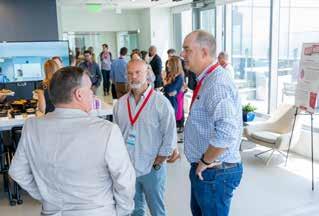
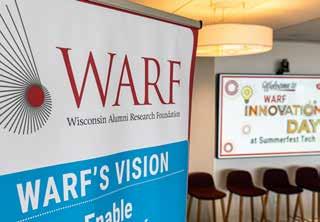
Investors and researchers come together at quick pitch event in Milwaukee
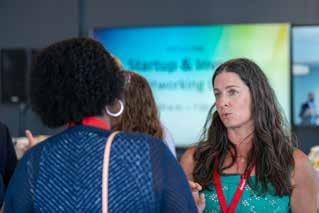
After months of polishing PowerPoints and refining their message, six UW presenters took the stage to pitch their ‘best stuff’ to some of Wisconsin’s top investors at Summerfest Tech in June.
Summerfest is an iconic festival of culture and entertainment that takes place annually in Milwaukee. For the first time this year, the event showcased top technologies in development at UW-Madison and two other UW System campuses.
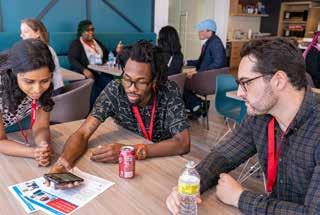
The pitch presentations – held at beautiful BMO Tower downtown –drew dozens of in-person and virtual investors who heard seven-minute talks on exciting innovations ranging from fusion power to bridge safety.
For the presenters it was a unique – and challenging – opportunity to get out of the lab and in front of potential investors. But practice makes perfect, and the teams worked closely with WARF Accelerator and Communications staff over the course of weeks and months to hone their message.
“Working with these innovators in crafting an effective pitch for an audience of investors was a unique and fun experience,” says Lesli Mark, WARF Accelerator Associate. “Through many iterations, we were able to develop pitches that were representative of each PI’s passion for the science, while demonstrating the value-add that their technology can bring to the world.”
The Quick Pitch lineup:
• Control and Disrupt: Next-Generation Semiconductors
Outperform Silicon

Mike Arnold, Professor of Materials Science & Engineering at UW-Madison
A team of UW-Madison materials scientists have developed a method for aligning atomically thin rolls of graphene – called carbon nanotubes – to enable next-generation electronics. The well-aligned, high-density carbon nanotubes act like tiny semiconducting wires that can significantly outperform silicon.
• RosetteArraysTM: Transforming Risk Assessment and Drug

Discovery for Neurodevelopmental Disorders
Randolph Ashton, Associate Professor of Biomedical Engineering at UW-Madison and Co-Founder/CEO of Neurosetta LLC
A startup called Neurosetta has developed a stem cell-based platform for modeling the developing human brain and spinal cord. Its technology could transform our understanding of how pharmaceuticals and chemicals impact the growing human brain during the earliest stages of life.
16
• MegaPerceptron: Revolutionizing the Health Care Ecosystem with AI
Sandeep Gopalakrishnan, Assistant Professor and Director of the Wound Healing and Tissue Repair Lab (WHTRL) at the UW-Milwaukee College of Nursing and CEO/Co-Founder
MegaPerceptron is advancing a smartphone solution for wound diagnosis and prognosis to be used collaboratively by care providers and patients. This technology allows wound images and/or 3-D depths to be captured and preprocessed on smartphones, with cloud-based AI algorithms used to assess wound conditions and suggest treatment plans.
• Beyond CBD: Optimized Hemp Cultivars
Mike Petersen, Senior Scientist at the Wisconsin Crop Innovation Center (WCIC) at UW-Madison (presented by Lesli Mark, WARF Accelerator Associate)
A team of UW-Madison researchers and WCIC staff is using state-of-the-art genetic engineering to improve industrial hemp. Leveraging their knowledge of crop genomics, they have developed a patented gene editing method that allows them to create optimized hemp cultivars with high-value traits.
• Health Monitoring and Imaging System for Concrete Structures
Adhira Sunkara, Assistant Director at WiSys
UW-Platteville researchers have developed a monitoring system for identifying interior defects and stress –including cracks as thin as a human hair – in concrete structures such as bridges. The non-destructive monitoring system enables the interior conditions in any cross section of a bridge to be visualized in 3-D without requiring the drilling of holes and can be used on in-service bridges.
• Realta Fusion: Breakthrough Physics for Clean Energy Generation
Kieran Furlong, Honorary Fellow, UW-Madison College of Letters & Science and CEO
The Wisconsin High-field Axisymmetric Mirror (WHAM) project is leveraging major advances in superconducting magnets and plasma heating to pursue commercially viable nuclear fusion power. Fusion is how energy is generated in the sun, yet it has been tremendously challenging to harness on Earth. This project seeks to pave the way to a comparatively low-cost fusion device that can be a net energy generator.
“Advancing technologies from the lab to the market takes all hands on deck,” says Greg Keenan, Senior Director of WARF Ventures & Accelerator. “We’re grateful to our many partners in Milwaukee, Platteville, Madison and around the state who made this forum possible.”
WARF Innovation Day at Summerfest Tech was presented in partnership with Michael Best Strategies and Venture Best.
 WARF’s Jeanan Yasiri Moe, VC and Moderator Nhi Lê, along with pitch presenters Kieran Furlong, Randolph Ashton, Sandeep Gopalakrishnan, Mike Arnold and WARF’s Lesli Mark
WARF’s Jeanan Yasiri Moe, VC and Moderator Nhi Lê, along with pitch presenters Kieran Furlong, Randolph Ashton, Sandeep Gopalakrishnan, Mike Arnold and WARF’s Lesli Mark
WARF THERAPEUTICS
As WARF Therapeutics begins its fifth year, the team reflects on how the portfolio has evolved: the milestones achieved, lessons learned, changes made and, most importantly, how WARF Therapeutics has impacted the UW-Madison research community.

WARF Therapeutics has provided more than $600K in grants to the UW community. These funds further developed the science of portfolio collaborators, supported drug discovery seminars across campus (WARF Therapeutics Seminar Series) and built novel capabilities to attract industry investment and partnerships (Chemistry Catalysis Center). In addition to helping achieve WARF’s mission to support the UW-Madison research community, these activities also amplify WARF Therapeutics and drive collaborative interest.
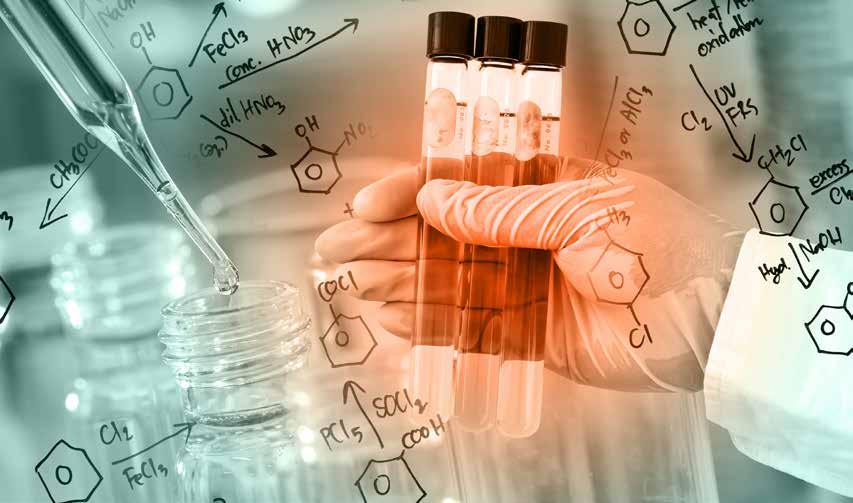
This year’s notable updates to the WARF Therapeutics portfolio include:
• Program 702 was hypothesized to have numerous applications in cancer and became the first program to be promoted to Stage 3, the first patent filed on a WARF Therapeutics invention, and the first asset to begin licensing conversations. However, the current data set did not support the original applications. Funding for the program has been suspended with any potential future development within the initiative pending new results from the PIs’ laboratories.

• Program 384, aimed at treating metastatic pancreatic cancer, was advanced to Stage 2 10 months after the program was initiated.
• Program 735, a novel modality called “theranostics,” selectively delivers radiation to the tissue while sparing normal cells and will target a form of kidney cancer. Because UW-Madison holds a competitive advantage in the field based on the unique resources on campus, the WARF Therapeutics Team, including the Scientific Advisory Board, agrees that this potential platform opportunity could sustain the portfolio into the future. Program 735 was promoted to Stage 2 at the May Scientific Advisory Board Meeting.
• Notable changes include increased transparency to the external community by highlighting and celebrating the PIs we are collaborating with.
18
WARF VENTURES SPOTLIGHT STUART THERAPEUTICS
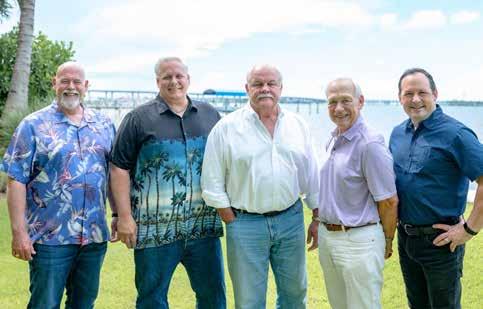

Championing a new approach to the treatment of chronic eye diseases
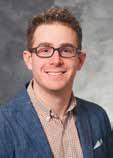

Stuart Therapeutics was founded in 2018 to treat chronic eye diseases in new ways. That same year, the company licensed technology from WARF to develop the first of a series of drug candidates for dry eye disease, PolyCol™. PolyCol is made up of synthesized polypeptide sequences, or collagen mimetic peptides (CMP), designed to repair damaged extracellular matrix (ECM) helical collagen structures, which play a key role in healthy tissues. These synthetic peptide strings were developed by UW-Madison emeritus professor Ron Raines.
“Collagen plays an active role in tissue homeostasis and is found throughout the body,” says Stuart Therapeutics CEO Eric Schlumpf. “We saw it as having broad potential as a therapeutic approach.”
The eye’s surface has a layer of epithelial cells, but dry eye disease causes a disruption in the tear film, leading to damage to the cells and nerves that support them. Stuart Therapeutics’ working hypothesis is that CMPs repair damaged helical collagen structures and restore collagen’s healthy cell signaling behavior. This results in restoration of the epithelial cells and the nerves in the cornea. Stuart Therapeutics ran a Phase 2 clinical trial from October 2020 to October 2021 that showed promising results.
“The trial was successful; patients responded to the therapeutic quite well,” says Joshua Carson of WARF Ventures, who licensed the technology to Stuart Therapeutics in 2018 and participated in Stuart Therapeutics’ first round of financing in February 2020. “It was well tolerated, with almost zero side effects. Most dry eye drugs on the market, like anti-inflammatories, have moderately uncomfortable side effects, like stinging, and PolyCol does not.”
“The Phase 2 clinical trial for dry eye disease demonstrated broad effectiveness, based on the patient sample size of approximately 50 patients in the high dose cohort,” says Schlumpf. “We are discovering more and more about the drug and its mechanism of action as we compare our laboratory results with the trial data. It appears that we have a beneficial effect on the corneal nerves, which translates to patient improvement in visual function, reduction in symptoms, and increase in tear production. These are all very positive outcomes for dry eye patients.”
The company also has promising research results for glaucoma, with a drug that protects the optic nerve, rather than focusing on reducing intraocular pressure, as current treatments do. The company is working with the FDA to design a clinical trial that recognizes this new approach to the disease.
“We also plan to pursue two additional major indications in ophthalmology,” says Schlumpf. “Our initial research suggests that we have significant opportunities in retinal diseases, and we plan to pursue those, either ourselves, or with partners in development.”
The FDA has approved Stuart Therapeutics’ Phase 3 plans, including its trial endpoints, so the company has a roadmap for their next clinical trial. They are currently fundraising for capital for their Phase 3 trial.
“Stuart Therapeutics is pursuing a completely differentiated approach to the treatment of ophthalmic diseases,” says Schlumpf. “The company is constantly breaking new ground, with an opportunity to provide patients with a therapeutic approach that appears to work fast and effectively.”
19
Stuart Therapeutics’ unique reparative tissue platform PolyCol™ provides much-needed relief for dry eye disease patients
Joshua Carson WARF Venture Manager
Stuart Therapeutics Leadership Team: Eric Schlumpf, CEO; Brian J. Del Buono, Exec VP; Shawn DeLorey, Exec VP; Robert Baratta, Chairman; David Calkins, Chief Science Officer


A NEW MODEL
WARF and Taconic partner to advance a novel mouse model of the human immune system.
As stand-ins for humans, mouse models are powerful tools long relied upon by pharmaceutical developers and the research community. Most new drug candidates, from statins to osteoporosis medications, are screened in “furry test tubes” before ever reaching a human patient. After all, mice share 92 percent of our DNA and have virtually the same set of protein encoding genes as humans – a fact attributable to a common mammalian ancestor approximately 80 million years ago. But even powerful tools have limitations, says Matthew Brown, Ph.D., Assistant Professor in the Department of Surgery.
“In important ways, mouse biology does not always align with human,” says Brown, who also leads the Humanized Mouse Core on campus. “Certain things don’t translate well.”
This biological gap can have real consequences for pharmaceutical companies. Treatments for cancer, diabetes and even Alzheimer’s disease that cured or benefited mice have failed in subsequent human trials. For this reason, recent years have seen the advance of “humanized” mouse strains genetically and surgically customized to more closely model human biology. Strains that replicate the human immune system are in high demand by drug makers looking to anticipate the human body’s response to new therapies. Currently, these immunologically customized mice are created using cord-blood or fetal-derived stem cells, which carry ethical concerns for some and are available only in limited quantities. The process is also time-consuming, and experimental reliability can be an issue.
Enter the NeoThy Mouse
Drawing on years of research and know-how, Brown and his team have now generated the “NeoThy Mouse,” a novel mouse model that utilizes surplus neonatal thymus tissue sourced from pediatric heart surgeries to create a more closely matched human immune system model.

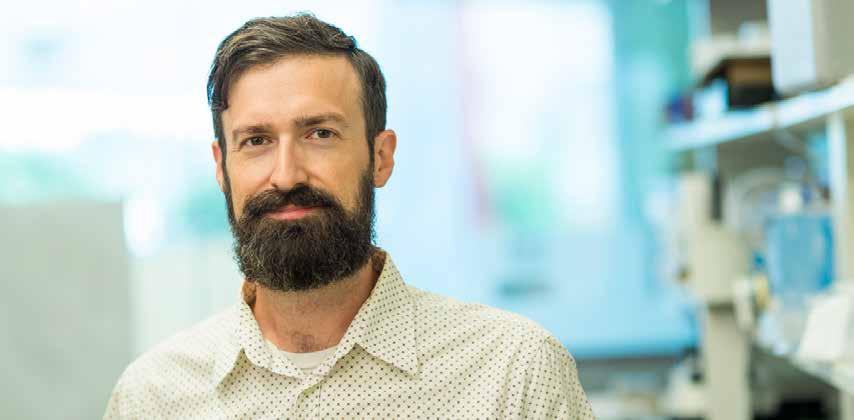
Among the potential advantages, the mice are generated without requiring fetal tissue, eliminating potential ethical concerns. They can also be generated more efficiently and in much greater quantities – more than 1,000 NeoThy mice can be made from a single thymus donor.
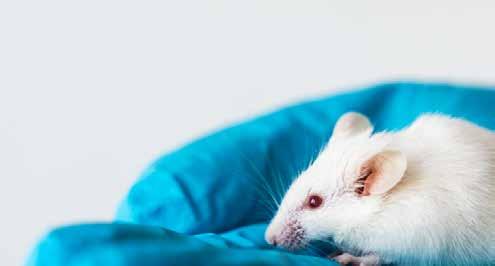
To validate these claims, a joint WARF Accelerator project was initiated with Taconic Biosciences, a leading provider of research models to the pharmaceutical market. This joint project was the first of its kind for WARF and was established with close collaboration between UW, WARF and Taconic scientists and business development staff.
This collaboration enabled crucial experiments that validated the model and showed it could be scaled up to meet the high-throughput needs of the pharmaceutical and biotech communities.
Prof. Brown says, “The WARF-funded research helped to advance our lab’s understanding of important scientific questions related to the humanizing tissue sources while at the same time facilitating commercialization of the model on a large scale, which is better suited to an industrial partner than to an academic research lab.”
Similarly, Taconic recognized the strength of the joint work, saying, “Working with Dr. Matthew Brown and the WARF licensing team at the University of Wisconsin has been an exceptionally rewarding and effective collaboration, one that we expect will have an immense impact on drug discovery and safety.”
From WARF’s perspective, this partnership resulted in a successful Accelerator-supported license with Taconic that will lead to UW-Madison research getting to market where it can make a difference and also return revenues to support future innovations.
“Professor Brown’s project is a strong example of close integration of industry collaboration and in-kind support,” says Mark Staudt, WARF Licensing Manager. “We’re excited to see Taconic bring NeoThy to customers working on translational programs that could one day improve human health for all.”
Matthew Brown, Asst. Prof. of Surgery
Mark Staudt WARF Licensing Manager
First-in-Class
By “starving” seizure-causing neurons, startup Hexokine Therapeutics takes fresh aim at an old problem.
For the approximately 156,000 people each year in the U.S. who suffer severe seizures lasting five minutes or more –a medical emergency called status epilepticus – the damage can be debilitating. Even fatal.
Only about 25 percent of these patients suffer from underlying epilepsy. Most cases are triggered by other factors such as head trauma, stroke or infections. But no matter how or why it started, the longer an episode goes on, the more dangerous and difficult to treat it becomes.
It can be a terrible and terrifying thing to behold, says Dr. Nathan Fountain, an epilepsy specialist and professor at the University of Virginia School of Medicine.
Fountain has spent much of his career designing and running clinical trials around epilepsy. A former chair of the FDA Advisory Committee for Central and Peripheral Nervous System Drugs, he has seen proposed solutions wax and wane.
“I have a somewhat unique confluence of clinical experience and regulatory experience, but I was never interested in the business aspects,” he says.
A conversation with a colleague from UW-Madison was destined to change all that.
A Dormant Idea Comes to Life

A generation ago, it was incidentally noted that depriving seizure-causing neurons of energy could stop the seizure. A compound with a clumsy name and an elegant mechanism of action – a compound called 2-deoxy-D-glucose – stopped seizures in rodent models of status epilepticus. It was an interesting observation, somewhat obscure and soon forgotten.

“No one noticed it back then because the compound [abbreviated 2DG] was used as a diagnostic imaging agent rather than as a therapy,” says Fountain.
Interest “lay dormant” until the early 2000s, when UW-Madison neurologist Tom Sutula and collaborators in the Department of Neurology recognized that 2DG had potentially therapeutic actions against acute seizures and chronic epilepsy. He approached Fountain as a collaborator in an NIH National Center for Advancing Translational Sciences program, “Bridging Interventional Development Gaps (NIH-NCATS-BrIDGs), which supports translation of basic observations toward commercialization and market introduction.
22
In partnership with WARF and NIH-NCATS-BrIDGs, they found that while chronic usage carried side effects, as a targeted intervention 2DG could be a game-changer in the field. The two physicians soon realized that moving 2DG to the clinic would take the next level of investment.
“The light bulb went off for us. I realized that venture capital groups and others were investing in ideas that were much less mature than ours and have lower chance of success than we have,” Fountain says. “We have something here that’s much more than an idea. It’s almost to the finish line.”
Fountain and Sutula launched their biotech, called Hexokine Therapeutics, in fall 2021 and within a few months acquired seed funding.


Looking ahead, they expect animal studies to conclude by early next year. This will pave the way to an FDA submission and clinical trials using intravenous 2DG to treat status epilepticus.
Fountain envisions 2DG as a second-line therapy to treat the 50 percent or so of patients who fail to respond to initial intervention.
“What makes 2DG so exciting is that it works differently from virtually any other drug currently on the market for treating seizures, epilepsy or neurological disorders generally,” says Rafael Diaz, WARF Licensing Manager. “We’re excited to partner with Hexokine in this endeavor to bring UW-Madison research closer to patients.”
By blocking uptake of glucose, 2DG literally starves seizure-causing neurons of energy. 2DG is potentially the first drug of its kind for treating status epilepticus.
The field is poised for innovation. Existing first-line therapies (e.g., benzodiazepines such as Valium) have been the go-to solution for decades, Fountain says. These drugs, known as GABA agonists, are effective for many patients. Still, thousands of others fail to respond or even develop resistance to the treatment.
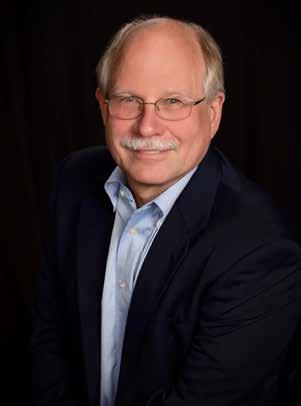
It is compelling to note that 2DG is routinely administered in small amounts during PET scans and has been safely used in this way in millions of patients. Of course, how the compound is tolerated as an acute, intravenous treatment for status epilepticus is another story waiting to be told.
“The steady support of WARF through processes of IP protection, advice about commercialization and regulatory challenges, and engagement with funding opportunities has been invaluable,” Sutula says. “We would not be where we are now without it.”
For Fountain – the once reluctant entrepreneur – this unexpected journey ends with a powerful vision.
“We’ll define success when we can sit next to the first person whose ongoing seizure we can stop with 2DG,” Fountain says. “That’s what we’re most looking forward to.”
23
Rafael Diaz WARF Licensing Manager
Thomas Sutula Prof. Emeritus of Neurology
SEEING AROUND THE BEND
By fundamentally rethinking how sensors capture and process light, a Boston-based startup with UW-Madison roots looks to revolutionize how machines perceive the world around us.
An autonomous vehicle cruising in the night. Darkness and fog. An obstacle around the corner undetectable to human eyes…
The scenario strikes a chord because it evokes a familiar danger and the limitations of human perception. It also illustrates one of countless technical challenges and opportunities confronting the competitive realm of computer vision.

Computer vision, as defined by IBM, is a field of artificial intelligence (AI) that enables computers and systems to derive meaningful information from digital images, videos and other visual inputs — and take action.
It all starts with light.
Sebastian Bauer, CEO of startup Ubicept, believes his company is on track to commercialize the best answer in the field.
Founded in 2021, Ubicept couples advanced algorithms with next-generation sensors to capture and process light in a fundamentally unique way. A way that builds upon years of computational imaging research pioneered at UW-Madison.
Or as Bauer describes it, “We are the brains to new types of eyes.”
Light Tells a Story
For Bauer, the journey to the helm of a buzzy young startup began as a postdoc in the lab of Andreas Velten, a Professor of Biostatistics and Medical Informatics at the UW School of Medicine and Public Health.
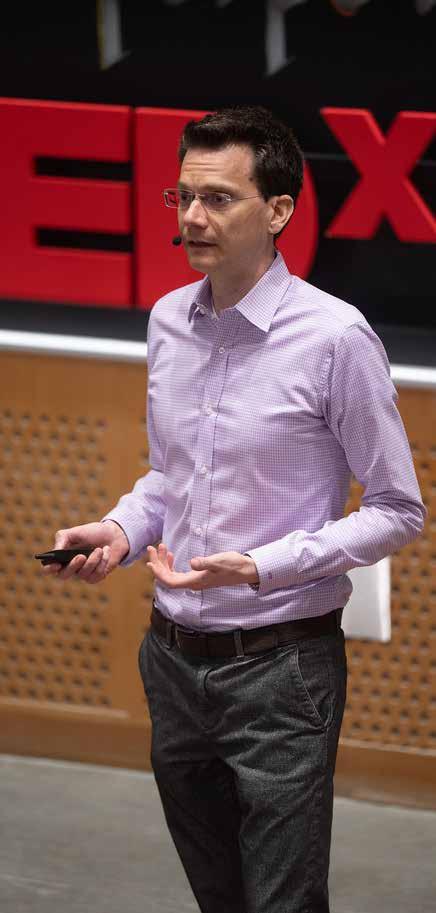
Velten’s group was pushing the limits of non-line-of-sight imaging. In other words, using sensors to “see” around corners by bouncing light off a surface and reconstructing an image based on the “echoes” that come back. All in the blink of a metaphorical eye.
Their findings were compelling. So were the potential real-world applications, from disaster relief and national defense to critical safety systems in future vehicles.
24
Sebastian Bauer, CEO of startup Ubicept
“This technology has tremendous safety implications that positively impact people every day,” says WARF Licensing Manager Michael Carey. “The technology’s ability to see around corners and in low light, in difficult-to-see situations is outstanding. This will positively impact children getting off busses in busy streets or garbage loaders managing blind spots. Lives will be saved by use of this technology.”
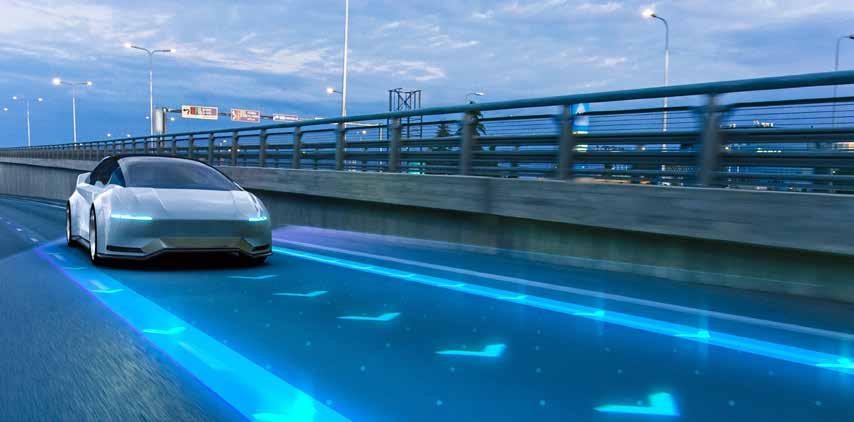
Bauer, always curious about entrepreneurship, was inspired by the idea of moving innovations beyond the walls of the university and into the hands of consumers.
WARF Accelerator is an excellent partner to academic entrepreneurs and proved to be one in this case as well. The program provided financial and mentoring support for Bauer as a postdoctoral researcher to continue to further the technology with an eye toward commercialization via a startup. With the support he was able to develop an early proof-of-concept prototype that enabled early customer discovery, acquisition and testing. These activities became crucial for fundraising efforts as the startup was formalized.
The Ubicept team started fundraising last year and is currently interfacing with top companies in several sectors. Velten remains an advising founder along with Associate Professor Mohit Gupta (Computer Sciences) whose innovations in single-photon imaging are world renowned. Single-photon sensors can capture individual photons of light with extremely high sensitivity and time resolution, making them ideal candidates for state-of-the-art 3-D cameras.
Bauer says that, while challenging, the process of building a tech startup has accomplished precisely what it should – confirming many assumptions while invalidating others along the way. It’s all part of the “fascinating journey.”

Looking back, Bauer credits the “generous spirit” of WARF-supported programs like Discovery to Product (D2P) and gBETA for nurturing a sense of community during the earliest – and often loneliest – stages of company exploration.
The dividends of such support are hard to quantify, he says. “But it is extremely valuable. It helps to be part of an ecosystem with like-minded peers and mentors, where someone really takes the time to help.”
The idea of encouraging more entrepreneurs resonates with Bauer. And he has a message for the next generation of engineers and computer scientists who, like him, yearn to take university innovations to the next level of development.
“Just try it.”
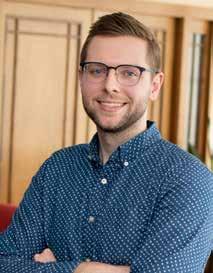
25
Micha el Carey WARF Licensing Manager

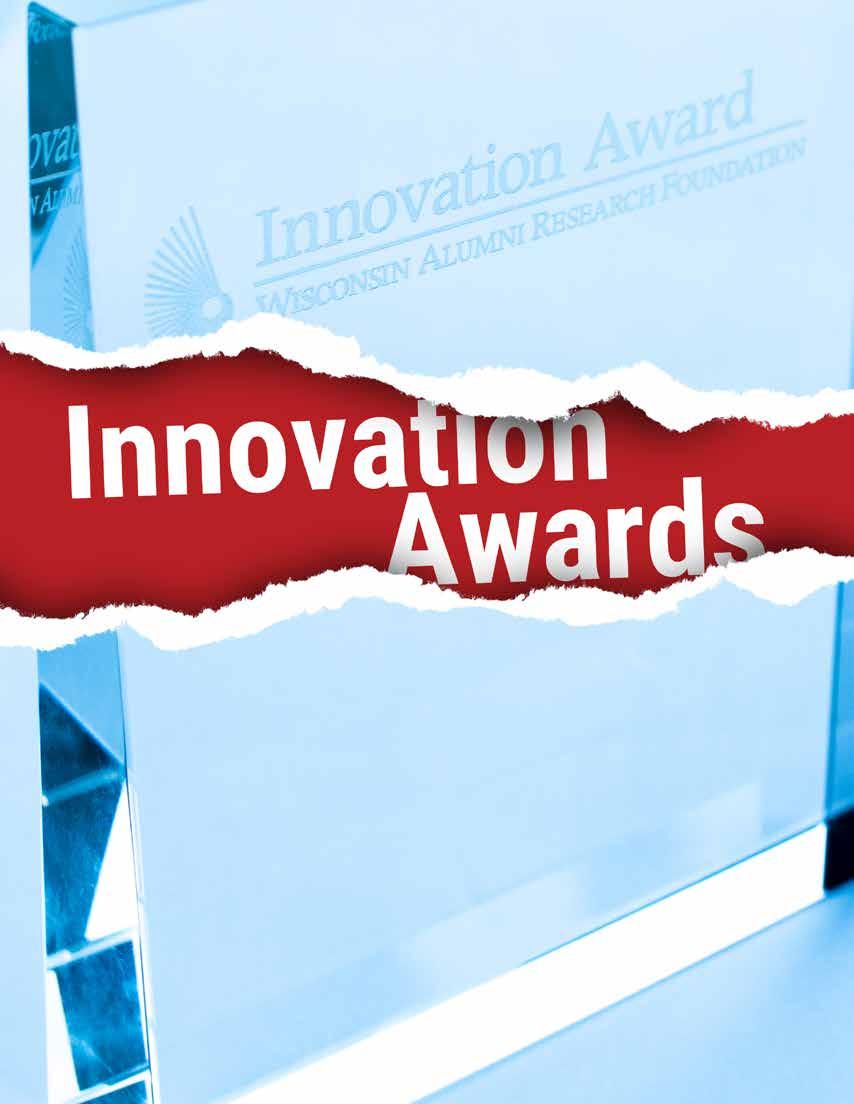
WARF Innovation Awards 2022
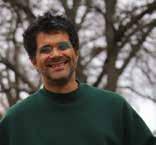
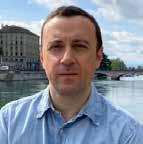


Making telecommunications more affordable
Asst. Prof. Victor Brar seeks to better understand the electronic, magnetic and optical behavior of materials at the atomic scale. His recent work with Seyoon Kim, a former research scientist in his lab, has led to a new method for controlling the optical signals used in telecommunications systems. The device they developed uses an inexpensive graphene sheet to modulate light waves, paving the way for low-cost fiber optic networks.

Testing kids for high cholesterol to prevent future issues


Pediatrics Prof. Mei Baker’s research focuses on the link between genetics and disease. She and clinical researcher Brian Conti developed a screening test for pediatric familial hypercholesterolemia, a common genetic disorder resulting from elevated levels of LDL cholesterol. When diagnosed early, the disease can be better managed and future issues, such as cardiovascular disease, are less likely to develop.
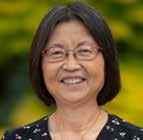
Testing the strength of soft materials
Asst. Prof. Corinne Henak and Assoc. Prof. Melih Eriten have interests in materials science and biomedical engineering, respectively. They teamed up to develop a method for testing and monitoring the strength and durability of soft materials. Their technique, which uses acoustic waves to measure a material’s property in real time, has applications in medicine, bioengineering, soft robotics and the food industry.
27
Brian Conti
Mei Baker
Melih Eriten
Corinne Henak
Victor Brar Seyoon Kim
Stronger material for defense and aerospace

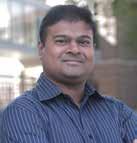

Asst. Prof. Ramathasan Thevamaran and postdoctoral researcher Jizhe Cai create innovative materials for extreme engineering applications. This team has developed a new, lightweight material made of carbon nanotubes that is stronger than Kevlar and could be used to develop protective equipment such as bulletproof vests and tank armor, as well as air- and spacecraft.
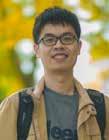
Innovative test for Sjögren’s syndrome
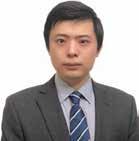
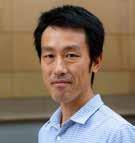


Assoc. Prof. Sara McCoy’s research focuses on autoimmune disorders such as Sjögren’s syndrome, rheumatoid arthritis, psoriasis and lupus. Her recent work with Assoc. Prof. Miriam Shelef, Professor Michael Newton and graduate researcher Zihao Zheng led to a new diagnostic test that eliminates the need for painful and invasive lip biopsies in patients with Sjögren’s syndrome, a debilitating disease that affects 4 million Americans. The test is based on Dr. McCoy’s discovery of novel autoantibodies that affect how the disease progresses.
Supercharging plants for a healthier planet
Assoc. Prof. Hiroshi Maeda studies the metabolic pathways in plants that are involved in amino acid production. He and postdoctoral researchers Ryo Yokoyama and Marcos Vinicius Viana de Oliveira have identified a genetic mutation that causes photosynthesis to go into hyperdrive. This discovery could lead to plants that can absorb more carbon from the atmosphere, as well as to a greener way of harvesting chemicals used in everything from pharmaceuticals to disinfectants.
 Hiroshi Maeda Marcos de Oliveira
Ramathasan Thevamaran
Michael Newton
Miriam Shelef
Jizhe Cai
Sara McCoy Zihao Zheng
Hiroshi Maeda Marcos de Oliveira
Ramathasan Thevamaran
Michael Newton
Miriam Shelef
Jizhe Cai
Sara McCoy Zihao Zheng


A NEW CHANC ELLOR
(and a New Trustee)

This past year saw the addition of new faces in four key leadership positions on the UW-Madison campus. Glenda Gillaspy became Dean of the College of Agricultural and Life Sciences, Rob Cramer was hired as Vice Chancellor for Finance and Administration (the Chief Financial Officer for UW-Madison), and Jay Rothman joined the UW System as its new President.
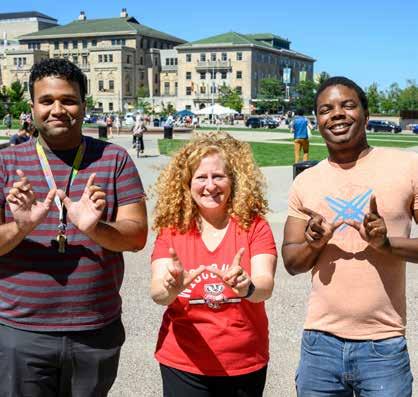
Last but not least, Jennifer Mnookin took over as the new Chancellor of UW-Madison. That makes her not only the leader of the university WARF’s mission pledges to support, but by virtue of her position, she also now serves as a full member of WARF’s Board of Trustees.
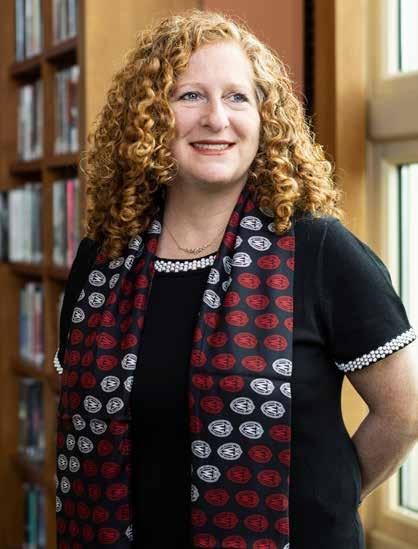
Chancellor Mnookin comes to UW-Madison from UCLA, where she served as Dean of the Law School. She also has a direct personal connection to WARF. When she donated a kidney to her father, the organ was preserved for cross-country transport by the UW Solution, patented by WARF and among our top 10 most successful inventions.
UW-Madison Chancellor-designate Jennifer Mnookin speaks to incoming students and their parents and guests during a welcome session of Student Orientation, Advising and Registration (SOAR) held in Union South’s Varsity Hall at the University of Wisconsin-Madison.
 Chancellor Mnookin poses with two students on Library Mall at the University of Wisconsin-Madison.
Jennifer Mnookin, Chancellor of UW-Madison
Chancellor Mnookin poses with two students on Library Mall at the University of Wisconsin-Madison.
Jennifer Mnookin, Chancellor of UW-Madison
Trustees Sprecher and Bobins Retire

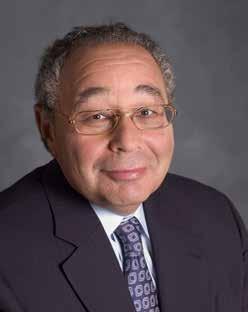


During its June and October meetings, the WARF Board honored two outgoing Trustees who retired after distinguished service.
Trustee Jeff Sprecher stepped down at the beginning of the summer having served since 2014. A 1978 graduate of UW-Madison with a Bachelor of Science in Chemical Engineering, Sprecher served on the Board’s Finance and Audit, Investment and Technology Commercialization Committees. WARF benefited greatly from his extensive expertise and experience as an influential entrepreneur, company founder and executive in the investing and trading industries.
In the fall, Trustee Norm Bobins retired. A successful banking executive and member of multiple corporation and nonprofit boards, Bobins served as Treasurer of the Board of Trustees and, during his tenure, chaired WARF’s Salary & Fringe Benefits and Finance & Audit Committees. He also sat on the Board’s Investment and Compensation & Pension Committees. Bobins earned a Bachelor of Arts in History from UW-Madison in 1964 and was first elected as a WARF Trustee in 2010.
WARF thanks Jeff Sprecher and Norm Bobins for their many contributions and wishes them all the best.
31
Norm Bobins
Jeff Sprecher
A science
TRAILBLAZER retires:
Stem cell researcher James Thomson’s legacy changed the future of biology
The developing human body will eventually grow from a tiny two-celled zygote to a massively complex system comprising more than 37 trillion cells. If a single cell represented one second in time, all of our cells combined would span 1.8 million years.
James Thomson helped the scientific world turn its attention to the shape-shifting stem cells that give rise to all of the building blocks of complex living organisms, from skin and bone, to hearts and blood, to neurons and brains.
After more than 30 years with UW-Madison and 15 years with the Morgridge Institute for Research, Thomson has retired.
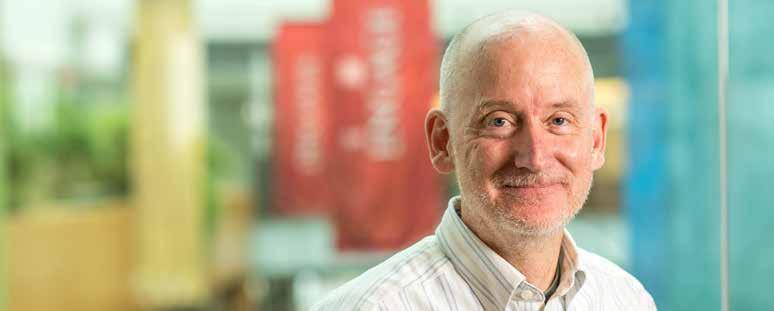
“There are few scientists in the world, across all of history, with the ability to translate their deep curiosity about life into discoveries that fundamentally change what’s possible for humanity,” says former UW-Madison Chancellor Rebecca Blank. “We are all fortunate that Jamie Thomson dedicated his own life and career to such pursuits, and we are especially grateful he did so at UW-Madison. His work has influenced generations of our students and scholars.”
Thomson will always be best known, as the cover of TIME Magazine trumpeted in summer 2001, as “the man who brought you stem cells.” His life’s work contains three quantum leaps in regenerative biology.
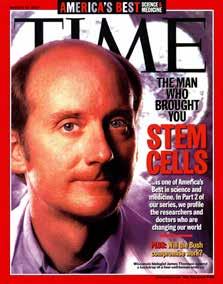
The first was in 1995, when he derived stem cells from non-human primates, the first time ever done in a species closely related to people. Then in 1998, he isolated five stem cell lines from human embryos, work that enabled stem cell discovery in thousands of labs around the world and spawned a prolonged, high-stakes bioethical debate in the U.S.
The third leap was in 2007, with the discovery of adult pluripotent stem cells, which offered a way of coaxing adult skin cells back to an original blank state.
Stem cell science now employs tens of thousands of scientists globally in industry and academia. Many are working in promising frontiers such as stopping or reversing blindness, and treating or preventing Parkinson’s disease and diabetes.
Stem cells have become ubiquitous tools in the world of drug development and testing. They sparked Proposition 71, a California referendum in 2004 that led to the investment of $5.5 billion in state funds to support stem cell-based medical advances.

And they’ve opened up wide basic science frontiers, permitting researchers across the globe to explore vast new questions about how biology works. WARF, a vital long-term supporter of Thomson’s research, created the organization WiCell in 1999 to enable distribution of Thomson’s original stem cell lines to scientists across the world.
Today, WiCell’s repository holds more than 1,500 stem cell lines, and more than 7,300 distributions have been made to more than 2,300 laboratories at 956 institutions across 43 countries globally.
32
The Wisconsin Idea at a The Warfarin Story: A National Historic Chemical Landmark
The American Chemical Society (ACS) honored the development of the blood thinner warfarin with the National Historic Chemical Landmark designation in a ceremony at UW-Madison on October 12, 2022. To celebrate, the UW-Madison Biochemistry Department, Wednesday Nite @ the Lab and WARF hosted a landmark groundbreaking ceremony at the DeLuca Biochemistry Complex, followed by a presentation about the history of warfarin.
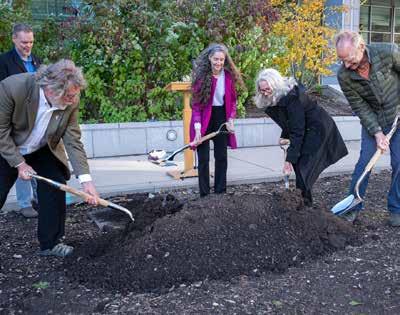
ACS established the National Historic Chemical Landmarks program in 1992 to recognize seminal events in the history of chemistry and increase awareness of the contributions of chemistry to society. Past landmarks include the invention of Polaroid instant photography, the discovery and production of penicillin, the invention of synthetic plastics and the works of such notable scientific figures as educator George Washington Carver and environmentalist Rachel Carson.
We can now add warfarin and its lead inventor, Karl Paul Link, to that distinguished list. The real story of warfarin’s discovery, long a source of local legend, was told at the ceremony by local author Doug Moe based on research for his forthcoming biography of Link. One weekend in February 1933, a farmer from northwest Wisconsin drove to Madison looking for the state veterinarian to diagnose a condition that was causing his cows to bleed to death. Instead, he found his way to the biochemistry department, where Professor Link and his student assistant recognized the signs of sweet clover disease. Link reoriented the work of his laboratory toward understanding the underlying biochemistry that caused the disease, and close to a decade later, isolated the first of series of anticoagulant compounds. WARF patented the invention and helped develop it into warfarin, which became the world’s most widely prescribed blood thinner (and, as it turned out, a highly effective rat poison).

That’s how a chance encounter between a farmer and a professor resulted in one of WARF’s most successful innovations. The farmer’s name was Ed Carlson, and as Doug tells the story, he may never have known that his trip to Madison led to a medical breakthrough used to treat millions of patients.
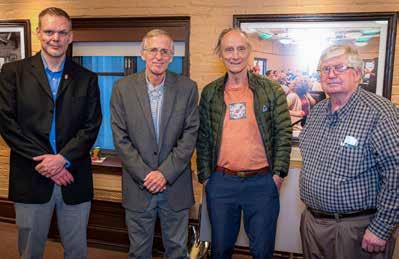
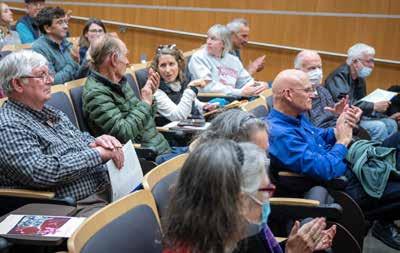
The ACS landmark plaque, now in the process of being forged, will become the centerpiece of a new Biochemistry Complex courtyard, which will soon be redesigned as a gathering place for today’s students and researchers to remember the history that came before as they contemplate the biochemistry innovations that will shape the future.
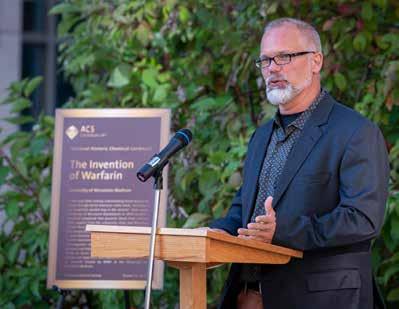 CEO Erik Iverson offered WARF’s groundbreaking shovel to Karl Paul Link’s son, Tom Link, during the ceremony.
Kevin Walters, Biochemistry Department Chair Brian Fox, ACS Board Member Lisa Balbes, CALS Dean Glenda Gillaspy and Tom Link broke ground for a courtyard to house the new landmark.
An engaged audience included Biochemistry Professor Emeritus Dave Nelson, Tom Link, Karl Paul Link’s granddaughter Andrea Banks and Vice Chancellor for Research and Graduate Education Steve Ackerman.
Kevin Walters, Doug Moe, Tom Link and Dave Nelson attended the reception after Doug’s presentation.
CEO Erik Iverson offered WARF’s groundbreaking shovel to Karl Paul Link’s son, Tom Link, during the ceremony.
Kevin Walters, Biochemistry Department Chair Brian Fox, ACS Board Member Lisa Balbes, CALS Dean Glenda Gillaspy and Tom Link broke ground for a courtyard to house the new landmark.
An engaged audience included Biochemistry Professor Emeritus Dave Nelson, Tom Link, Karl Paul Link’s granddaughter Andrea Banks and Vice Chancellor for Research and Graduate Education Steve Ackerman.
Kevin Walters, Doug Moe, Tom Link and Dave Nelson attended the reception after Doug’s presentation.
Connecting With Our Campus Community

Outreach tailgate connects grad students with WARF
On a busy Saturday in September, Steenbock’s on Orchard filled with 40+ red t-shirted graduate students enjoying brats and beers in advance of the Badger football game.
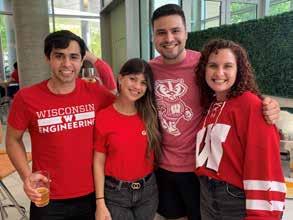
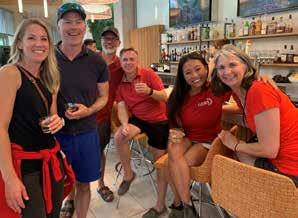
WARF hosted the tailgate, which included students from GERS (Graduate Engineering Research Scholars), a unique fellowship program designed to offer underrepresented students a support network of peers and professional development opportunities. The gathering provided WARF IP, Licensing and Ventures staff an opportunity to meet casually with the students and share more information about WARF and why students should consider disclosing ideas from their research endeavors.
“It was a great way to connect 1x1 with students who are working in labs,” says Jeanine Burmania, Senior Director of IP and Licensing.
The students, many of whom had never been to a football game, were grateful for the opportunity.
“Thank you so much for hosting us! I had an amazing time and was able to meet so many wonderful people,” says Valerie Odeh.
“It was amazing to see such a connected and welcoming community come together!” says Giovanni Artiglo.
National gap cited:
Jennifer Gottwald co-authors article on women in innovation

According to the U.S. Patent and Trademark Office, 20% of patents list a woman and 12% of all inventors were women. Although recent years have shown an upward trend in those percentages, at the current rate, gender equity in patenting won't be achieved until 2092.
Jennifer Gottwald WARF Director of Licensing
In an effort to understand factors that encouraged and discouraged academic women’s participation in technology commercialization, Jennifer Gottwald, Director of Licensing, and eight other tech transfer professionals surveyed academic women involved in innovation, invention and/or entrepreneurship. The 168 respondents were from public and private research institutions from all regions of the United States.
Published in February, the paper, Engaging More Women in Academic Innovation: Findings and Recommendations, highlighted the results and offered a series of recommendations to foster greater engagement among women and other underrepresented populations in the innovation life cycle.
34
Careers and Beers connects grad students and postdocs with alternative science careers


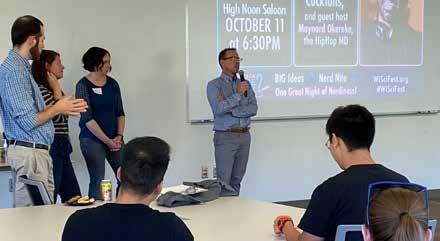
The Careers and Beers series, held three times in the spring and three in the fall, offered opportunities for UW-Madison grad students and postdocs to network with community members and explore alternative science career options after graduate school. Dozens of people attended each session of the evening series, which featured informal chats with UW alums who have careers in law, business, marketing and communications, policy/government and research administration and leadership.
The mission of the WARF Ambassador Program is to reach into the graduate student and postdoc communities to increase awareness of WARF on campus, and the team is always looking for ways to engage those communities.
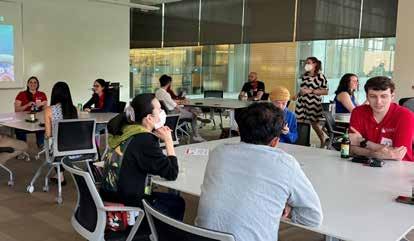
When Beth Fischer, Director of IP, Life Sciences and Manager of the Ambassador Program, learned about another technology transfer office that hosted regular opportunities for graduate students and postdocs to learn more about non-traditional careers in science, she opted to start a similar program at WARF.
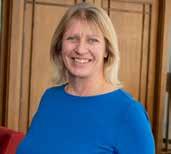
Beth says that these types of opportunities are great ways to engage the graduate student and postdoc communities as there is a real hunger to learn about careers outside of academia. “We decided to structure the events as informally as possible to promote discussion and networking,” she says.
Both attendees and participants/speakers have really enjoyed the Careers and Beers sessions. And they come with additional benefits.
“Not only are we providing opportunities for graduate students and postdocs to learn about careers outside of academic research (including those associated with technology transfer), we have an audience to whom we can market disclosing inventions and events from WARF’s Programming Team,” says Beth.
WARF Ambassador Jill Kyzer, who helped organize the sessions, says, “I’ve been very pleased with how the Careers and Beers events have gone. The grad students and postdocs that I’ve talked to have all been appreciative of how informative the sessions have been. The events were useful to all stages of graduate students, giving early grad students ideas for future careers and senior grad students (as well as postdocs) the ability to network with people in the fields they were interested in.”
35
Be th Fischer WARF Director of IP, Life Sciences
AUTM Central
In June, Jennifer Gottwald, Kevin Walters and Mark Staudt headed to Texas for the AUTM Central Region Meeting, a gathering of tech transfer professionals located in the Central time zone. Mark is a key contributor to the AUTM Central planning committee, Jennifer spoke on a panel about university license negotiation, and Kevin moderated the Howard Bremer Plenary (named in honor of WARF’s longtime patent counsel and a former president of AUTM).
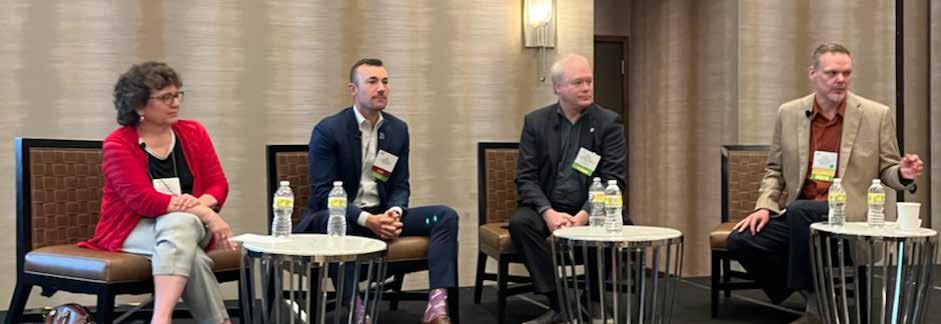
IPWatchdog LIVE

In September, Erik Iverson and Kevin Walters traveled to Richardson, Texas, to attend IPWatchdog LIVE, a conference put on by the influential blog that’s one of the leading sources for news and analysis on patents and innovation. Erik spoke on a panel with Bayh-Dole Coalition Executive Director Joe Allen where they discussed the state of technology transfer in the Biden administration.
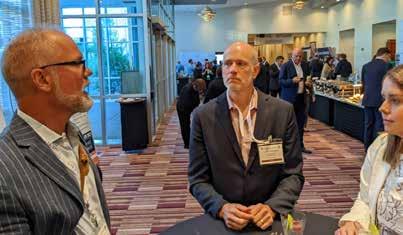
WiSys SPARK Symposium
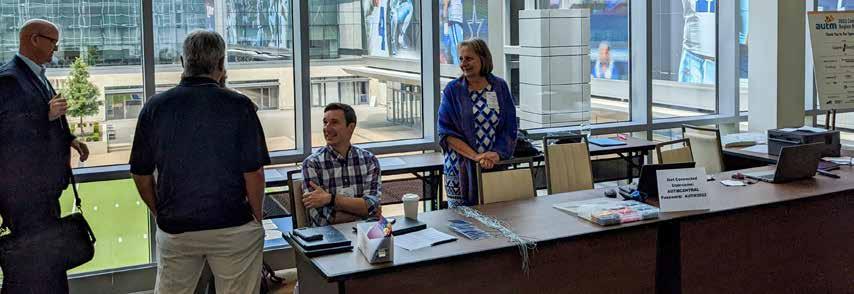
In August, UW-La Crosse hosted the WiSys SPARK Symposium, an annual event that brings together researchers and innovators from across the UW System. Jennifer Gottwald and Kevin Walters spoke at a panel on Sustainability in Agriculture, part of the ongoing Bicentennial Innovation Challenges initiative. They were joined onstage by Adhira Sunkara and Arjun Sanga from WiSys.

Legislative Visits

After a two-year hiatus, this spring marked the return to in-person government relations visits for UW-Madison’s State and Federal Relations, and once again, WARF staff joined them.

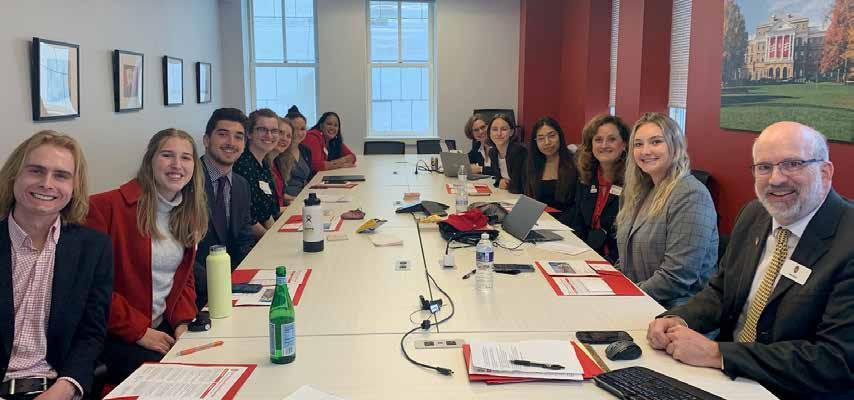
On April 6, the Federal Relations office, together with the Wisconsin Foundation and Alumni Association (WFAA), hosted UW-Madison in Washington, D.C. WARF Director of Strategic Communication and Public Affairs Jeanan Yasiri Moe and Public Affairs Analyst Kevin Walters were in attendance and met with the offices of Rep. Ron Kind (D-La Crosse), Rep. Mike Gallagher (R-Green Bay), Rep. Bryan Steil (R-Janesville) and Rep. Gwen Moore (D-Milwaukee).
Three weeks later, WFAA and State Relations hosted UW-Madison Day at the State Capitol, which gave Kevin the chance to meet with State Senator Kelda Roys (D-Madison) and the staff of State Representative Kevin Petersen (R-Waupaca).

The shoe was on the other foot this past August when Congressional staffers from the Wisconsin delegation visited Madison for a campus tour that culminated with a reception at the Meat Science & Animal Biologics Discovery Building, completed in 2020 and funded with support from WARF.
Throughout the year, WARF staff maintain regular contact with our elected representatives to keep them educated and informed about our activities and important developments.
37


Sparking curiosity throughout the state at the Wisconsin Science Festival
The Wisconsin Science Festival’s statewide celebration returned for its 12th year with a full week of activities October 10-16.


Hundreds of events in communities throughout Wisconsin invited people of all ages to drop in and explore dozens of offerings, including hands-on activities, talks with scientists and authors, films, performances, nature hikes, take-home science kits and so much more.
This year, both Superintendent Jill Underly of the Wisconsin Department of Public Instruction and Governor Tony Evers issued proclamations that officially declared October 10-16 as Wisconsin Science Week to highlight the importance of Wisconsin citizens engaging with science in all aspects of their lives.

“The festival creates a unique gathering of events that celebrate science, art and technology across our entire state, highlighting the vast amount of expertise and curiosity we can be proud of as Wisconsinites,” says Sam Mulrooney, incoming Wisconsin Science Festival Director.
Each year, the Wisconsin Science Festival highlights a specific aspect of the world around us. This year, as a nod to the International Year of Glass, we focused on the many ways glass impacts science, art and technology.

Laura Heisler, Co-Founder and outgoing Festival Director, says, “Glass can help us see new perspectives, improve our communication and further explore our world and beyond. From Platteville to Sussex, Marshfield to Madison, we held a number of events around the state that highlighted the importance of glass in science, industry, art, medicine and more.”
Among the glass-themed events was Kiss My Glass, an evening at the High Noon Saloon that combined the popular Big Ideas for Busy People with Nerd Nite. More than 100 science enthusiasts heard fast-paced flash talks on glass, sampled fluorescent cocktails, experimented with hands-on activities and were entertained by Maynard Okereke, the HipHop MD. Presenter Filiz Yesilkoy, Assistant Professor of Biomedical Engineering, says, “Never thought giving a scientific talk in a bar would be this much fun!”
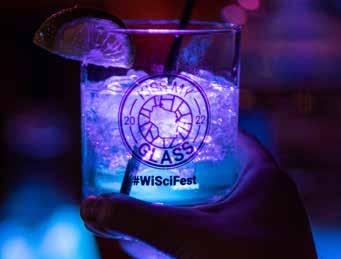
Other glass-focused highlights included glassblowing demonstrations at the Bergstrom-Mahler Museum of Glass in Neenah and the UW Glass Lab in Madison, self-guided art tours in Sheboygan and Madison and other activities for children and learners of all ages at local libraries and museums.
Back for its fifth year, the ever-popular Science on the Square event again fused with the Madison Night Market to create a unique way to explore hands-on science activities while also supporting local businesses and vendors.


STEM-themed activities (including several highlighting the importance of glass) mixed with vendor tents and indoor businesses throughout State Street. Despite the chilly, windy weather, thousands of visitors turned out downtown to explore the exhibits, demonstrations, talks and more.
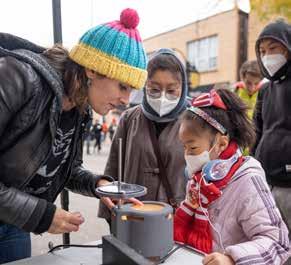


Following its successful debut at the 2021 festival, Science in a Bag returned with 2,000 free STEM kits distributed to participating libraries across the state for youth in grades K-12. Inside were hands-on science and art activities that connect to relevant research conducted throughout Wisconsin. For example, some participants made their own mini-mural to inspire a larger installation that will be on display at the Discovery Building, while others created stained glass models and experimented with light.
“The beauty of the festival is seeing this network blossom and grow each year to create newfound community connections or bolster existing relationships throughout Wisconsin,” says Sam, who is also a Program Manager for WARF and the Discovery Connections team. “Libraries connect to nearby companies, pub owners engage with local scientists, and campus organizations take nature hikes with community groups.”
Save the date to join us for next year’s festival, October 16-22, 2023!

40
Crossroads of Ideas connects university research with the community
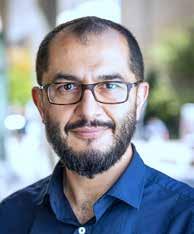

Crossroads of Ideas – a collaboration among WARF, the Morgridge Institute for Research and the Wisconsin Institute for Discovery – is a public lecture series held monthly during the academic year that addresses topics that matter to our community and are the subject of research at UW-Madison.
The name Crossroads of Ideas reflects the importance of the Discovery Building as a place for campus and community to learn about thought-provoking topics. Crossroads refers to both the building’s central location on campus and the intersection of the dozens of different disciplines that work and study here.
“We are fortunate to have tremendous experts on our campus to help us connect to research on the kinds of questions that impact our daily lives,” says Laura Heisler, Director of Programming.
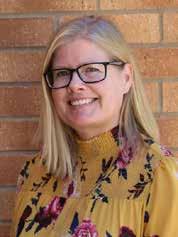
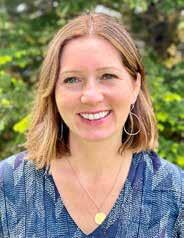
For the 2022-23 academic year, Crossroads of Ideas teamed up with the UW-Madison Office of the Vice Chancellor for Research and Graduate Education for a four-part miniseries – one for each division – that celebrates outstanding UW researchers who have received WARF faculty awards.
These faculty have earned the respect of their peers and their scholarship community for excellence in their fields and have been awarded WARF Named Professorships, Kellett Fellowships and/or Romnes Awards from the OVCRGE.
“I’m proud to team up with WARF to showcase some of our outstanding faculty who have recently received WARF sponsored awards,” says Steve Ackerman, Vice Chancellor for Research and Graduate Education. “The faculty featured in this miniseries are highly regarded for their dedication to the research, teaching, outreach and public service missions of the university. Crossroads of Ideas brings them to center stage for a special public engagement opportunity.”
The first talk in the miniseries highlighted an award winner from Arts and Humanities: Amy Quan Barry, the Lorraine Hansberry Professor of English. A novelist, poet and playwright, Barry read from various works spanning her 20-plus year career at UW-Madison.

A second talk featured Megan Moreno, Professor of Pediatrics and Adjunct Professor of Educational Psychology, from Biological Sciences. The news media has frequently promoted concerns about social media and mental health for teens, including “Facebook depression” and concerns about addiction. But does this moral panic align with the current evidence? Moreno untangled the evidence around the relationship between adolescent social media use and mental health.
Why do we build robots? And why are we fascinated by them? In February, an awardee from Physical Sciences – Bilge Mutlu, Professor of Computer Sciences – will argue that it is because we want to see ourselves in places we live, things we use – even technology. So, robots reflect our desire to see ourselves in the technologies we use day to day.
The series concludes with an award winner from Social Sciences. Foreign electoral intervention is a powerful tool of foreign policy, and understanding how the U.S. public thinks about this issue is crucial. In February, Jessica L.P. Weeks, a Professor of Political Science and the H.H. Douglas Weaver Chair in Diplomacy and International Relations, will explore how Americans think about foreign intervention in U.S. elections, U.S. candidates who solicit such intervention, and finally, U.S. intervention in the elections of other countries.
“The award-winning faculty speaking in this year’s series within a series represent some of the most exciting scholarship taking place at UW-Madison and have been recognized as outstanding by their peers,” says Laura. “We are so thrilled to be able to feature these remarkable voices in this year’s Crossroads of Ideas lineup.”
41
Megan Moreno
Jessica L.P. Weeks
Amy Quan Barry
Bilge Mutlu

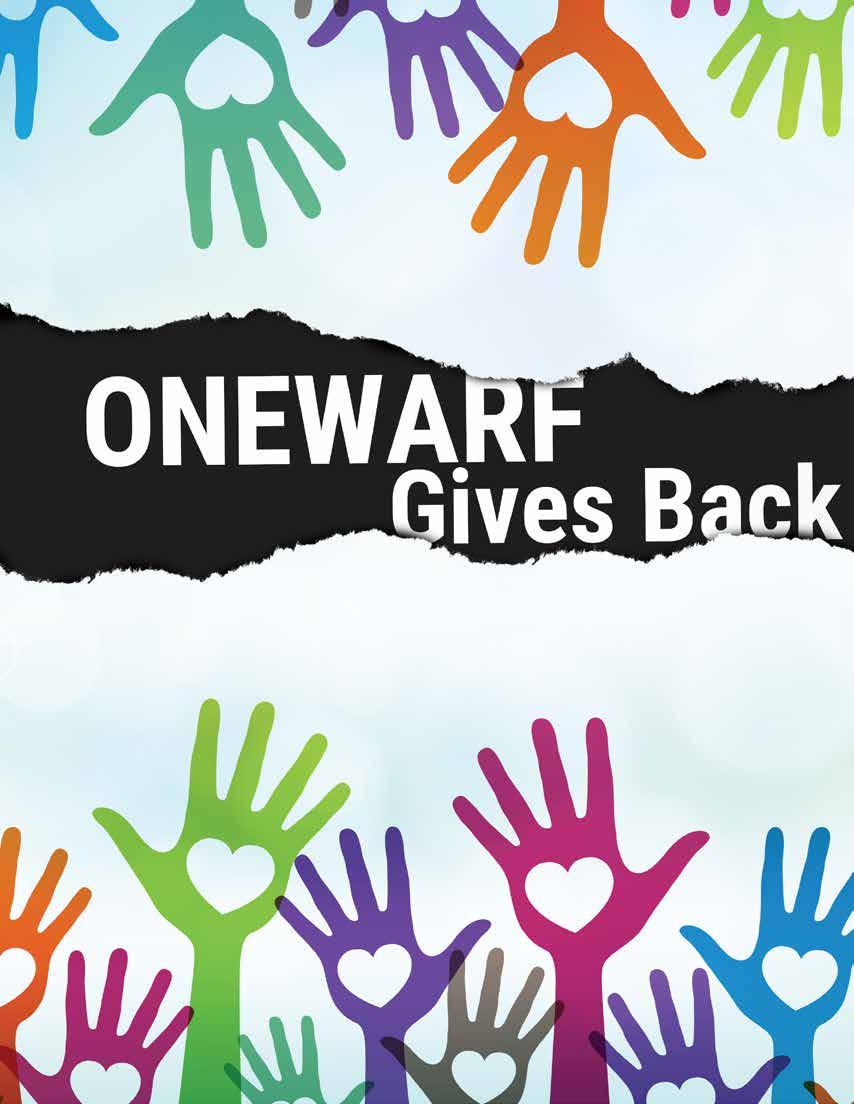
WARF staff and their families devote hundreds of hours to support and strengthen our community. From food banks to blood drives, citizen science to school supplies, our staff come together to make a difference

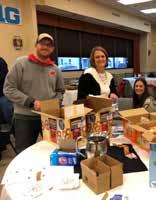
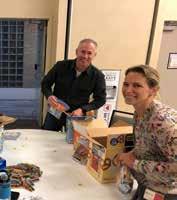
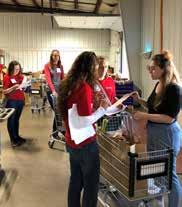
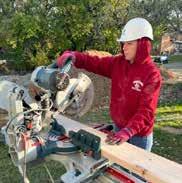
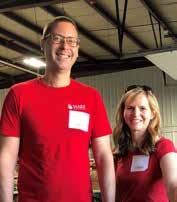
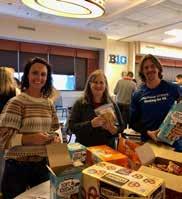
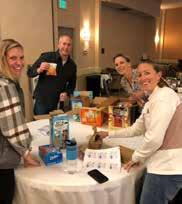
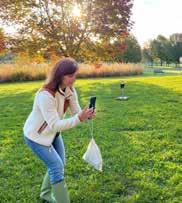
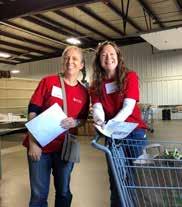

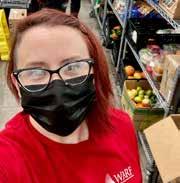


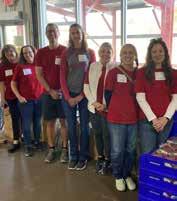


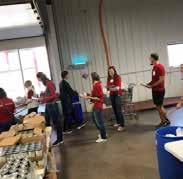





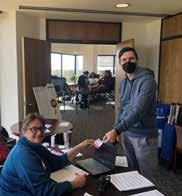

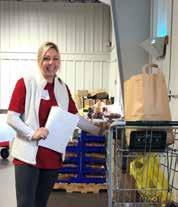
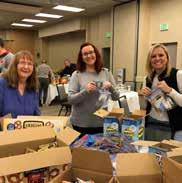
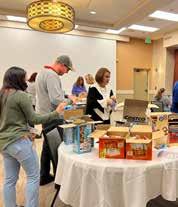
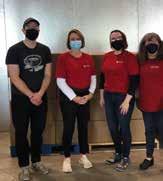

43
Remembering 1947 -
CARL
2022
Carl Gulbrandsen, whose leadership and vision during his 16 years as managing director of WARF resulted in unprecedented technological innovation and a doubling of the foundation’s investment portfolio to $2.6 billion, died October 17, 2022, after an extended illness.
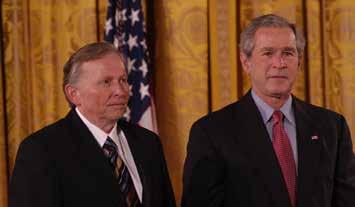
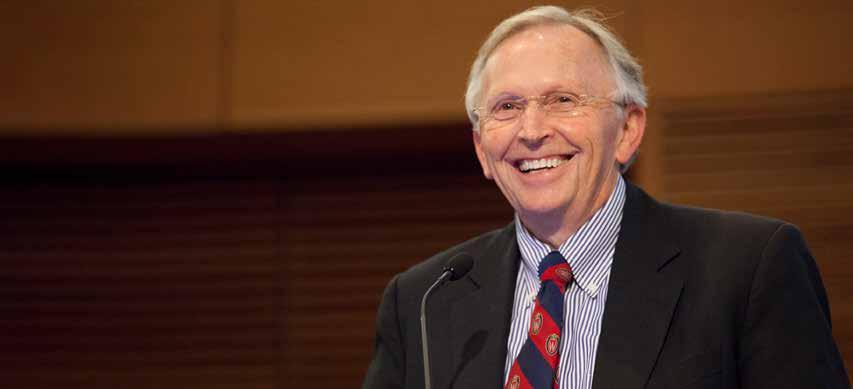
Under Carl’s leadership, WARF was issued 1,980 patents, including 10 of the 20 most successful inventions in the foundation’s almost 100-year history, and more than tripled its annual support to the university, from $43.0 million in fiscal year 2000 to $156.8 million in fiscal year 2016. He also spearheaded the creation of the WiCell Research Institute, the WiSys Technology Foundation, the Morgridge Institute for Research and the WARF-operated Discovery Building.

A memorial service for Carl was held at Discovery. Those delivering comments included John and Tashia Morgridge, Chancellor Emeritus Rebecca Blank, Morgridge Institute CEO Brad Schwartz and WARF Board Chair Jim Berbee.
Here is an edited excerpt of Jim’s comments:
Carl loved the University of Wisconsin. Carl was born and raised in Wisconsin and earned a law degree and a Ph.D. in physiology at UW-Madison. His commitment to basic research at our university and at the Morgridge Institute speaks to the core of his being. His combination of scientific training and legal expertise made him a great champion of WARF’s mission to support research, and he
brought Badger pride and Wisconsin values to everything he did – values that he would often call “Norwegian,” but that we might call “the Wisconsin idea.”
In addition to his commitment to UW, Carl was a strategist. WARF’s day-to-day activities are all about advancing individual technologies to the market, but Carl always understood that those technologies grew out of a world-class research enterprise and that their success depended on a robust ecosystem to support innovation and entrepreneurship throughout Wisconsin. Not content to rest easy on patenting successes, he never hesitated to reinvest WARF’s resources with an eye toward ensuring Wisconsin would remain a global leader in research and innovation.
The creation of the Morgridge Institute for Research is perhaps the greatest example of his foresight and leadership. The institute was created at a time when federal funding for stem cell research faced an uncertain future and when loud voices and political headwinds challenged this still emerging field of fundamental research. Carl, recognizing the importance and potential not only of stem cells but of regenerative medicine more broadly, strove to ensure that Wisconsin would maintain the research environment needed to compete well into the future.
Carl Gulbrandsen was unafraid of hard work, controversy or conflict, and he did it all with his usual steadfast commitment to doing the right thing for Wisconsin and for the world. And the world and all of us are better because of him.
Carl and President George W. Bush at the ceremony where WARF was awarded the National Medal of Technology in 2003.
Carl and his wife Mary at the National Medal of Technology awards ceremony in 2003.















































 WARF’s Jeanan Yasiri Moe, VC and Moderator Nhi Lê, along with pitch presenters Kieran Furlong, Randolph Ashton, Sandeep Gopalakrishnan, Mike Arnold and WARF’s Lesli Mark
WARF’s Jeanan Yasiri Moe, VC and Moderator Nhi Lê, along with pitch presenters Kieran Furlong, Randolph Ashton, Sandeep Gopalakrishnan, Mike Arnold and WARF’s Lesli Mark



































 Hiroshi Maeda Marcos de Oliveira
Ramathasan Thevamaran
Michael Newton
Miriam Shelef
Jizhe Cai
Sara McCoy Zihao Zheng
Hiroshi Maeda Marcos de Oliveira
Ramathasan Thevamaran
Michael Newton
Miriam Shelef
Jizhe Cai
Sara McCoy Zihao Zheng




 Chancellor Mnookin poses with two students on Library Mall at the University of Wisconsin-Madison.
Jennifer Mnookin, Chancellor of UW-Madison
Chancellor Mnookin poses with two students on Library Mall at the University of Wisconsin-Madison.
Jennifer Mnookin, Chancellor of UW-Madison









 CEO Erik Iverson offered WARF’s groundbreaking shovel to Karl Paul Link’s son, Tom Link, during the ceremony.
Kevin Walters, Biochemistry Department Chair Brian Fox, ACS Board Member Lisa Balbes, CALS Dean Glenda Gillaspy and Tom Link broke ground for a courtyard to house the new landmark.
An engaged audience included Biochemistry Professor Emeritus Dave Nelson, Tom Link, Karl Paul Link’s granddaughter Andrea Banks and Vice Chancellor for Research and Graduate Education Steve Ackerman.
Kevin Walters, Doug Moe, Tom Link and Dave Nelson attended the reception after Doug’s presentation.
CEO Erik Iverson offered WARF’s groundbreaking shovel to Karl Paul Link’s son, Tom Link, during the ceremony.
Kevin Walters, Biochemistry Department Chair Brian Fox, ACS Board Member Lisa Balbes, CALS Dean Glenda Gillaspy and Tom Link broke ground for a courtyard to house the new landmark.
An engaged audience included Biochemistry Professor Emeritus Dave Nelson, Tom Link, Karl Paul Link’s granddaughter Andrea Banks and Vice Chancellor for Research and Graduate Education Steve Ackerman.
Kevin Walters, Doug Moe, Tom Link and Dave Nelson attended the reception after Doug’s presentation.































































